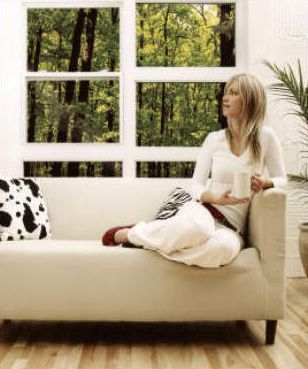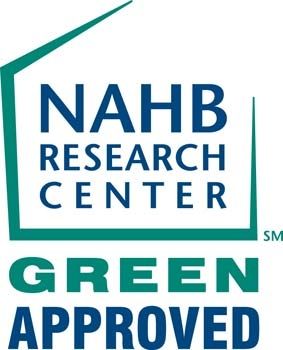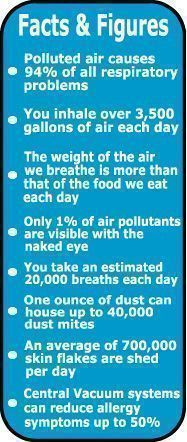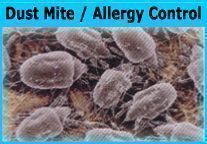Go Green

It's just better for the environment.
The next generation of central vacuums is here now!
Save Energy/Money • Help Save the Environment

 This
year, the National Association of Homebuilders wi
ll
ratify National Green Building Standards that offer a
significant boost for the central vacuum industry. These
new standards will allow a builder who installs a
central vacuum system to claim
five points toward having a
home platinum certified, which requires a total of 108
points. The NAHB standards are the strongest endorsement
that use of a central vacuum system drastically improves
the quality of air in your home. In 2005, the estimated
number of builders utilizing Green standards increased
by 20, and an additional 30% the following year. Out of
those builders, two-thirds of them have said they
believed that building green is here to stay and not
just a fad. When asked what green features were
important to their buyers, 83% of the responses from
builders said indoor air quality, which ranked second
only to energy efficiency. About half of the builders
also said that building green helped them improve their
sales and increased their traffic.
This
year, the National Association of Homebuilders wi
ll
ratify National Green Building Standards that offer a
significant boost for the central vacuum industry. These
new standards will allow a builder who installs a
central vacuum system to claim
five points toward having a
home platinum certified, which requires a total of 108
points. The NAHB standards are the strongest endorsement
that use of a central vacuum system drastically improves
the quality of air in your home. In 2005, the estimated
number of builders utilizing Green standards increased
by 20, and an additional 30% the following year. Out of
those builders, two-thirds of them have said they
believed that building green is here to stay and not
just a fad. When asked what green features were
important to their buyers, 83% of the responses from
builders said indoor air quality, which ranked second
only to energy efficiency. About half of the builders
also said that building green helped them improve their
sales and increased their traffic.

Caring for the environment is something which we would all agree is essential for maintaining a good quality of life. Unfortunately, proclaiming the need to protect the environment and actually doing something about it are sometimes worlds apart. We take it for granted that products are produced with minimum effect on the natural world. We offer quality products designed to last for many years and which maintain a high standard ecologically. This we feel is the best contribution to give a production process which looks after and cares for the environment.
Today's homes are tighter and better insulated than ever before. This means more indoor contaminants are trapped inside your home. The US Protection agency reveals 6 out of 10 homes are "sick" and are potentially hazardous. Indoor air quality can be up to five times worse than outdoor air. Small wonder that respiratory ailments like asthma are at record high levels. Ordinary house dust is plentiful and contains skin flakes, hair, food particles, pet dander, insect parts and feces, and whatever your shoes can drag in including animal waste, mold, pollen and pesticides.
 Indoor air
pollution is one of the most common problems
addressed by allergists. A central vacuum system
if often recommended for removing pollutants
since 100% of pollens, bacteria, pet dander
vacuumed are exhausted out of the home when
vented outdoors. Researchers at the University
of California at Davis School of Medicine
revealed that use of a central vacuum system
reduced nasal allergy symptoms by as much as
47%, eye symptoms by as much as 61% and improved
indoor air quality by 52%.
Indoor air
pollution is one of the most common problems
addressed by allergists. A central vacuum system
if often recommended for removing pollutants
since 100% of pollens, bacteria, pet dander
vacuumed are exhausted out of the home when
vented outdoors. Researchers at the University
of California at Davis School of Medicine
revealed that use of a central vacuum system
reduced nasal allergy symptoms by as much as
47%, eye symptoms by as much as 61% and improved
indoor air quality by 52%.
|
Reduction in Allergy Symptoms Results from a UC-David clinical study |
|||
| Sleep: 44% | Non-Nasal: 48% | Nasal: 47% | Eye: 61% |
No other technology cleans as efficiently and effectively as a central cleaning system. It is by far the best choice in making your home healthier and cleaner. If you were to examine your carpet through a microscope, you would see millions of microscopic organisms per square foot. mold spores, pollen, dirt, dust, bits of food, pet dander and fur all inhabit the vastly huge world of carpeting. Simply walking across the surface of your carpeting stirs up lighter particles which often remain suspended mid-air for up to half an hour. These tiny airborne particles (which are visible to the eye when reflected in a sun beam shining through a window) are often the cause of watery eyes, shortness of breath, coughing, lethargy, wheezing and sneezing for those who suffer from allergies or asthma.
Be part of
the
Green Environmental Movement!

Save time, money, and
energy with Green products.
Drainvac Earth Friendly Central Vacuums
Congratulations to ThinkVacuums.com for
being featured on the TLC Network!
New Central Vacuum System Green Approved


Living green represents a commitment to make products that are easily recyclable, contain no toxic elements and do not release a significant amount of pollutants into the air. It's a way to conserve and save energy and materials and reduce the size of landfills which can be harmful to the environment.
In the "Green" market, there are 3 different aspects to the marketing behind it. The first being the most important, the reduction of the amount of energy consumed. By using a central vacuum over a conventional upright or canister vacuum, you stand to reduce the amount of energy consumed drastically. Second, what health aspects are increased by cleaning with a central vacuum? Does it actually add to a healthy home? And finally, do the manufacturers actually produce their products using an Environmental Management System in their factory and are the dealers following this effort?

|
What makes a central vacuum green? |
||
| Q: While "going green" is definitely a hot trend in the cleaning industry today, it seems everyone has his or her own definition of what green means. How do you define it? | A: Green cleaning consists of measures that improve the environment while causing the least harm to it. This is a complex issue since many products labeled green - chemicals, for instance - have an upside and a downside. | |
| Q: Many in the industry favor the development of a green certification process for services and products, including vacuum cleaners. Just how would you characterize or qualify a green vacuum? | A: The Carpet and Rug Institute (CRI) - a leading authority that works closely with carpet and equipment manufacturers and has funded considerable research - is perhaps the most qualified for such a task. | |
|
1.
Superior Filtration.
Select a filtration system
that retains 99 percent of particles one micron or smaller. The
tiny airborne dust and dirt you can't see is the biggest health
threat. Vacuums should be tested in a sealed chamber to detect
all sources of particles emanating from the unit, rather than
just from the filter or exhaust. |
||
Important Facts About The Air Your Breathe

American Lung Association
Allergy sufferer's symptoms can be improved up to 61% when using a central vacuum system. "It's the best investment for you can do for your health"
University of California
Davis School of Medicine
 Using a central vacuum system significantly reduces dust mites, pollens,
animal dander and other allergy causing agents from
your home.
Using a central vacuum system significantly reduces dust mites, pollens,
animal dander and other allergy causing agents from
your home.U.S. EPA
Central vacuum systems are among the best indoor air quality investments for your home. Also, adding to the value of your home.
BUILDER Magazine
Going Beyond Green Vacuums

Simple things around the house that you can do to save energy
• Do Full Loads of Laundry
Whenever you wash just a few clothes or dishes at a time rather than waiting for a full load to gather, you're wasting water, power, and money. The average American family of four washes about 540 loads of laundry a year, which consumes up to 21,000 gallons of water; and more than 150 loads of dishes, which uses about 1,500 gallons. Most of the energy consumed by washers goes toward heating the water - about 90% in the clothes washer and about 80% in the dishwasher. Combining half-loads, choosing shorter cycles and using cold or warm water rather than hot water racks up savings.
• Recycle Old Electronics
Americans tossed out an incredible 5.5 billion pounds of electronics (TV's, stereos, cell phones, computers) in 2005, according to the EPA. Only about 12.5% of this was recovered for recycling. The result was millions of pounds of chemicals and heavy metals ended up in the ground even though it's easier than ever to recycle electronics. The Consumer Electronics Association created a website to help people find a recycling center in their area. You could collect electronics in a box and make a drop-off a few times a year, for example. Their website also provides a list of things from laptops to baby monitors that are easier on the environment and your energy bill.
• Fix Leaks!
 The next time you fill up a glass of water, think about this: we each use about 100 gallons a day, enough to fill
1,600 glasses. Household water consumption has increased by 200% since 1950, even though the
population has grown by only 90%. As a result, more than 36 states are expected to face water
shortages in the next six years. Stemming the flow is as easy as fixing a leaky faucet or
toilet, a dripping faucet can waste up to 74 gallons a day, a leaking toilet up to 200 gallons a day!
The next time you fill up a glass of water, think about this: we each use about 100 gallons a day, enough to fill
1,600 glasses. Household water consumption has increased by 200% since 1950, even though the
population has grown by only 90%. As a result, more than 36 states are expected to face water
shortages in the next six years. Stemming the flow is as easy as fixing a leaky faucet or
toilet, a dripping faucet can waste up to 74 gallons a day, a leaking toilet up to 200 gallons a day!

Drainvac, Green Approved Product

Have been approved for points toward National Green Building Certification to the ICC 700-2008 National Green Building Standard as shown below. The NAHB Research Center hereby authorizes accredited verifiers to award these points toward certification when the products are used in accordance with the conditions shown below and the manufacturer’s installation instructions.
This information has been verified by independent third-party testing or evaluation.
Certificate #00157
PRATIQUE # 902.5
Description : This central vacuum system must be vented to the outside.
Signé par : Robert L. Hill, Directeur des Laboratoires Scientifiques et des Programmes de Certification Centre de Recherche NAHB • 400 Boulevard Prince George • Upper Marlboro, MD 20774 •

None of the companies mentioned above are sponsoring or affiliated with Thinkvacuums.com













 2.
Energy efficient.
Greener vacuums should use less
"energy" - less electrical power, but also less human energy.
Green is associated with lower energy costs or electrical usage,
but we've never heard anyone talk about how much physiological
energy - human energy - is expended to clean a square foot.
2.
Energy efficient.
Greener vacuums should use less
"energy" - less electrical power, but also less human energy.
Green is associated with lower energy costs or electrical usage,
but we've never heard anyone talk about how much physiological
energy - human energy - is expended to clean a square foot. 4.
Worker-friendly filtration.
To be green, vacuums
must have great filtration system, but the filter setup must
also be easy to access, maintain, or change. Keeping a filter
clean is the trick to having good filtration and pickup
efficiency. Some vacuums have filters that are terribly hard to
clean, while others are simply impossible to get completely
clean. If changing or cleaning a filter is an inconvenient or
filthy job, workers are less likely to do it. And if they don't
clean or change the filters, the vacuums won't work effectively
and certainly are not improving Indoor Environmental Quality.
4.
Worker-friendly filtration.
To be green, vacuums
must have great filtration system, but the filter setup must
also be easy to access, maintain, or change. Keeping a filter
clean is the trick to having good filtration and pickup
efficiency. Some vacuums have filters that are terribly hard to
clean, while others are simply impossible to get completely
clean. If changing or cleaning a filter is an inconvenient or
filthy job, workers are less likely to do it. And if they don't
clean or change the filters, the vacuums won't work effectively
and certainly are not improving Indoor Environmental Quality.
Log In
Create New Account